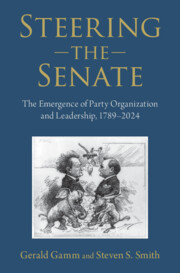Book contents
- Steering the Senate
- Steering the Senate
- Copyright page
- Dedication
- Contents
- Figures
- Tables
- Preface and Acknowledgments
- 1 Individual Goals and Senate Party Organization
- 2 Presiding Officer, 1789–1914
- 3 Caucus, 1789–1879
- 4 Steering Committee, 1856–1913
- 5 Arthur Pue Gorman, the Federal Elections Bill, and the Invention of Elected Floor Leadership, 1890–1913
- 6 Leaders and Whips, 1913–1924
- 7 Divergent Paths and the Consolidation of Leadership Structures, 1923–1944
- 8 Party Infrastructure, 1945–1980
- 9 Polarization, Competition, and Centralization, 1981–2024
- 10 Conclusion
- Appendix
- References
- Index
- References
References
Published online by Cambridge University Press: 27 June 2025
- Steering the Senate
- Steering the Senate
- Copyright page
- Dedication
- Contents
- Figures
- Tables
- Preface and Acknowledgments
- 1 Individual Goals and Senate Party Organization
- 2 Presiding Officer, 1789–1914
- 3 Caucus, 1789–1879
- 4 Steering Committee, 1856–1913
- 5 Arthur Pue Gorman, the Federal Elections Bill, and the Invention of Elected Floor Leadership, 1890–1913
- 6 Leaders and Whips, 1913–1924
- 7 Divergent Paths and the Consolidation of Leadership Structures, 1923–1944
- 8 Party Infrastructure, 1945–1980
- 9 Polarization, Competition, and Centralization, 1981–2024
- 10 Conclusion
- Appendix
- References
- Index
- References
Information
- Type
- Chapter
- Information
- Steering the SenateThe Emergence of Party Organization and Leadership, 1789–2024, pp. 437 - 460Publisher: Cambridge University PressPrint publication year: 2025
